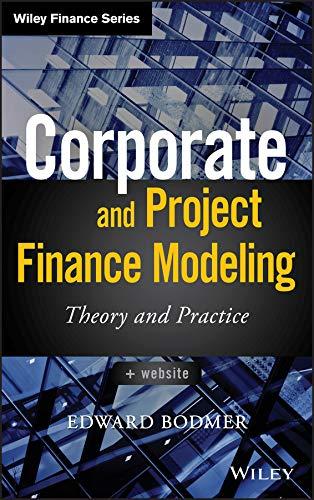Question
Federated Manufacturing is considering a major capital expenditure to begin production of a major new product. Key facts and assumptions about this new product appear
Federated Manufacturing is considering a major capital expenditure to begin production of a major new product. Keyfacts and assumptions about this new product appear below. Using this information, answer the questions following.
Facts and Assumptions
| Yield to maturity on long-term government bonds | 5% |
| Yield to maturity on company long-term bonds | 7% |
| Market price of risk | 6.9% |
| Estimated company and project asset beta | .70 |
| Stock price per share | $60 |
| Number of shares outstanding | 2 mil |
| Market value of interest-bearing debt outstanding | 80 mil |
| Tax rate | 35% |
| Inflation rate | 3% |
| Initial cost of investment | $200 mil |
| Year 1 selling price per unit | $80 |
| Year 1 variable manufacturing cost per unit | $55 |
| Year 1 general selling & administrative expenses | $200 |
| Expected project life | 8 years |
| Salvage value | $40 mil |
| Depreciation schedule | Straight-line |
| Working capital | 20% as % of sales |
| yr | 0 | 1 | 2 | 3 | 4 | 5 | 6 | 7 | 8 |
| unit sales | - | 2 | 10 | 20 | 23 | 24 | 23 | 22 | 15 |
a. Estimate Federated's equity beta
b. Estimate Federated's cost of equity capital
c. Estimate Federated's weighted-average cost of capital
d. Estimate the after-tax cash flows relevant to the investment. Assume the salvage value is realized in year 8 and working capital is liquidated in year 9.
e. Estimate the investment's net present value
f. Estimate the investment's internal rate of return. Does the investment appear attractive financially?
g. Estimate the present value of the investment's economic value added. (Note that the salvage value is captured in the annual EVAs.)
h. In market value terms, Federated's debt to capital ratio is 40%. Assume the company will finance the investment in the same proportions and estimate the cash flows from and to equity. (Assume the company will use an 8-year, 7% loan to be repaid in equal annual installments.)
i. Estimate the net present value of the equity cash flows. (That is, analyze the investment from the equity perspective.)
j. Estimate the internal rate of return to equity.
k. Why is the NPV from the entity perspective higher than the NPV from the equity perspective, while the IRRs are in just the reverse order?
l. Does the equity perspective tell you any more or less about the merits of the investment than the entity perspective? Which analysis is easier to perform?
Step by Step Solution
There are 3 Steps involved in it
Step: 1

Get Instant Access to Expert-Tailored Solutions
See step-by-step solutions with expert insights and AI powered tools for academic success
Step: 2

Step: 3

Ace Your Homework with AI
Get the answers you need in no time with our AI-driven, step-by-step assistance
Get Started


